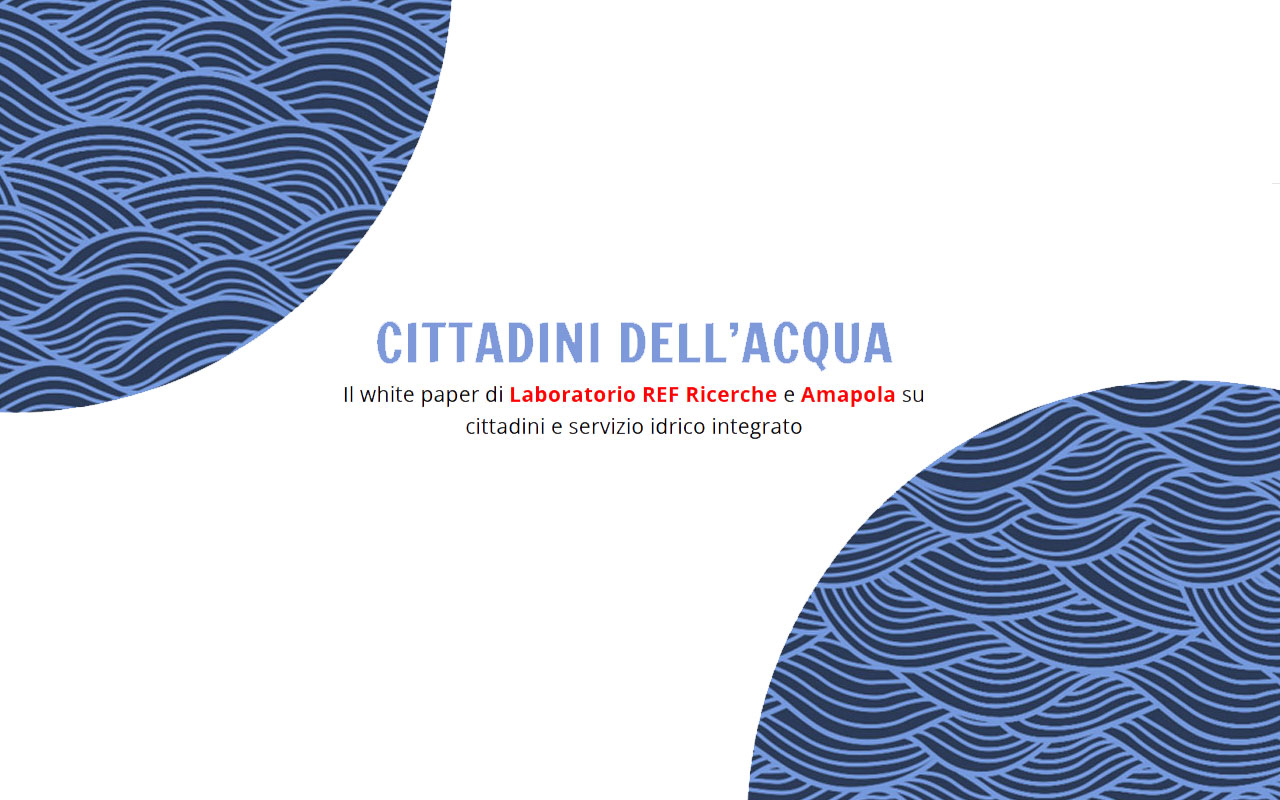Dal costo della bolletta all’uso dell’acqua del rubinetto fino alle ragioni del malcontento, il white paper di REF Ricerche in collaborazione con Amapola fornisce un quadro integrato per individuare percorsi concreti di azione e innovazione.
Conoscenze confuse, scarsa consapevolezza del valore della risorsa, dialogo difficile e anche qualche problema di fiducia. È questo il quadro dipinto dall’ultimo white paper del Laboratorio Ref Ricerche in collaborazione con Amapola, che approfondisce percezioni e valutazioni dei cittadini rispetto al servizio idrico integrato. Una distanza che va compresa e contestualizzata ma soprattutto affrontata attraverso specifici percorsi di coinvolgimento, ascolto e dialogo, a cui sarà dedicata una seconda pubblicazione di approfondimento.
Ma chi è il gestore?
La ricerca rileva una generale mancanza di conoscenze rispetto ad aspetti centrali del servizio. Tra questi, l’identità stessa dell’operatore: meno di un cittadino su due sa chi è il gestore del servizio idrico del proprio territorio, l’11% ammette di non saperlo, il 14% ritiene che si tratti dello Stato, della Regione o della Provincia – soggetti sicuramente errati – e il 30% che si tratti del Comune.
«Nonostante il passaggio del SII dagli enti locali a un ambito professionalizzato – cioè ad aziende industriali – sia un percorso avviato ormai trent’anni fa, tale transizione è ancora faticosamente in corso in alcune regioni» commenta Donato Berardi, direttore del think tank di REF Ricerche. «Le persone non hanno ancora interiorizzato l’uscita dal servizio idrico integrato dalla sfera di influenza della politica e dalla finanza pubblica. Questo aspetto con ogni probabilità si lega al mancato riconoscimento della bolletta idrica come presupposto economico ineludibile di ogni miglioramento del servizio».
Servizi: lontano dagli occhi, lontano dal cuore.
Anche la natura dei servizi forniti è percepita in maniera distorta: per un cittadino su sei il gestore si occupa solo della fornitura di acqua potabile e meno di un cittadino su due sa che il gestore si occupa anche di controlli della qualità e della potabilità dell’acqua. Insomma, i cittadini continuano a credere in gran parte che siano soprattutto i servizi che “entrano” ed “escono” dalle case quelli svolti dal gestore – ossia fornitura dell’acqua e fognatura.
Costo e valore del servizio.
Rispetto alla bolletta, quattro intervistati su dieci pensano che sia l’azienda del servizio idrico a decidere in autonomia la tariffa, senza conoscere quindi l’esistenza di un’Autorità di Regolazione nazionale (ARERA). La stessa confusione rispetto alla tariffa e alle sue dinamiche si riscontra in un altro dato: solo il 40% dei cittadini riconosce l’effettivo costo di un metro cubo di acqua, rispetto a un 30% che è completamente fuori strada e un altro 30% che ammette di non avere idea. «Il non sapere chi è il responsabile dei soldi riscossi, dell’uso che di questi si fa, dei servizi inclusi nella tariffa, insieme alla distanza tra prezzo e valore dell’acqua, porta a leggere la bolletta come un balzello da pagare, piuttosto che come il costo della risorsa, del servizio e del parziale ripristino della risorsa stessa» spiega Berardi.
Acqua del rubinetto tra geografia e generazioni.
La diffidenza nei confronti dell’acqua del rubinetto persiste. Circa un cittadino su tre è convinto che la cosiddetta “Acqua del Sindaco” non sia buona. La scelta di consumare acqua del rubinetto pare essere una questione geografica e generazionale. I più giovani, forse sollecitati dalla green revolution di cui sono principali portavoce, sono più sensibili al tema della sostenibilità e la privilegiano: la sceglie il 57% fra i 18 e i 24 anni, rispetto al 47% dichiarato dagli over 64. Differentemente, la quota di coloro che reputano l’acqua del rubinetto di buona qualità varia in modo significativo tra Nord (77%), Centro (70%) e Sud (66%) in modo armonico rispetto al consumo di acqua del rubinetto, denotando così una scelta che è sovente condizionata dalla qualità– presunta o reale – dell’acqua erogata.
Il punto di vista degli addetti ai lavori.
Il white paper di REF Ricerche e Amapola non si limita a delineare e mappare la distanza tra cittadini e servizio idrico, ma mette in dialogo la loro visione del settore con quella più consapevole degli addetti ai lavori attraverso una indagine su due fronti. «L’obiettivo è costruire un ideale punto di contatto tra le due esperienze, evidenziandone prossimità e distanze, per suggerire strategie e percorsi integrati e orientati a una maggiore condivisione» racconta Luca Valpreda, founder di Amapola.
Futuro, qualità del servizio, digitalizzazione, obiettivi di sostenibilità: mettere a confronto le aspettative dei cittadini e la competenza degli esperti – dimensioni a volte allineate, altre volte distanti tra loro – è la premessa necessaria per ricostruire il legame tra il servizio e i suoi stakeholder e orientare così il settore verso politiche più efficaci, sostenibili, condivise.
Pragmatici e dissidenti.
La ricerca individua anche una dimensione di cittadini in “crisi” con il servizio idrico e gli operatori, nell’accezione originale e neutra del termine, ossia nella ricerca di un cambiamento rispetto al passato. Sono i gruppi dei pragmatici (47%) e dei dissidenti (13%): i primi rilevano qualche tipo di insoddisfazione rispetto al SII in maniera consapevole e moderata, i secondi hanno posizioni radicali e ideologiche (“l’acqua non andrebbe pagata”). In totale, il 60% dei rispondenti segnala almeno un motivo di insoddisfazione nei confronti del servizio: di questo gruppo, il 34% indica più di un versante di insoddisfazione.
«Sui cittadini che abbiamo definito pragmatici, è possibile innestare un processo di recupero della fiducia incardinato sul miglioramento del servizio stesso e delle dinamiche relazionali con il gestore» spiega Valpreda. «Ascolto, dialogo, confronto sono ambiti nevralgici e non sacrificabili per chi, occupandosi di un bene comune come la risorsa idrica, è legato a doppio filo ai propri stakeholder. Per questo, il paper prevede una seconda uscita nella quale si analizzeranno, in una sorta di tassonomia del malcontento, i motivi dietro l’insoddisfazione dei cittadini, le risposte emotive dominanti e soprattutto i relativi percorsi di informazione, comunicazione e partecipazione da attivare di volta in volta».
La ricerca integrale è scaricabile qui.


